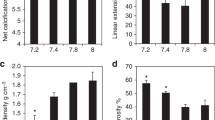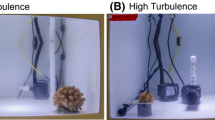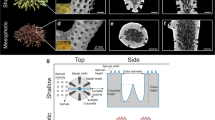Abstract
Though seawater movement is among the important factors that maintain healthy conditions on coral reefs, little is known about the effects of seawater turbulence on the growth of coral primary polyps. We cultured aposymbiotic primary polyps of Acropora digitifera with and without seawater turbulence and investigated how seawater turbulence affected the physical characteristics of the polyp skeleton. Results showed that seawater turbulence increased the amount of skeletal carbonate and directly influenced calcification of coral hosts. Three-dimensional morphological measurements by X-ray micro-computed tomography revealed that seawater turbulence increased the thickness of the skeletal branches of polyps. Greater thickness of the skeletal branches and increased horizontal growth may significantly enhance survival of primary coral polyps during early life stages before the establishment of algal symbioses.


Similar content being viewed by others
References
Allemand D, Tambutté E, Zoccola D, Tambutté S (2011) Coral calcification, cell to reefs. In: Dubinsky Z, Srambler N (eds) Coral Reefs; An Ecosystem in Transition. Springer, Netherland, pp 119–150
Boudreau BP, Jørgensen BB (2001) The Benthic Boundary Layer. Oxford University Press, New York, NY
Comeau S, Carpenter RC, Edmunds PJ (2013)) Coral reef calcifiers buffer their response to ocean acidification using both bicarbonate and carbonate. Proc. R. Soc. B 280
Finelli CM, Helmuth BST, Pentcheff ND, Wethey DS (2006) Water flow influences oxygen transport and photosynthetic efficiency in corals. Coral Reefs 25:47–57
Helmuth B, Sebens K (1993) The influence of colony morphology and orientation to flow on particle capture by the scleractinian coral Agaricia agaricites (Linnaeus). J Exp Mar Biol Ecol 165:251–278
Hongo C, Kayanne H (2011) Key species of hermatypic coral for reef formation in the northwest Pacific during Holocene sea-level change. Mar Geol 279:162–177
Inoue M, Shinmen K, Kawahata H, Nakamura T, Tanaka Y, Kato A, Shinzato C, Iguchi A, Kan H, Suzuki A, Sakai K (2012) Estimate of calcification responses to thermal and freshening stresses based on culture experiments with symbiotic and aposymbiotic primary polyps of a coral, Acropora digitifera. Global Planet Change 92–93:1–7
IPCC (2013) Climate change 2013, in The Physical Science Basis, Contribution of Working Group I to the Fifth Assessment Report of the Intergovernmental Panel on Climate Change, edited by T. F. Stocker et al., 1535 pp., Cambridge Univ. Press, Cambridge, U. K
Iwao K, Fujisawa T, Hatta M (2002) A cnidarian neuropeptide of the GLWamide family induces metamorphosis of reef-building corals in the genus Acropora. Coral Reefs 21:127–129
Iwasaki S, Kimoto K, Sasaki O, Kano H, Honda MC, Okazaki Y (2015) Observation of the dissolution process of Globigerina bulloides tests (planktic foraminifera) by X-ray microcomputed tomography. Paleoceanography 30:317–331
Iwasaki S, Inoue M, Suzuki A, Sasaki O, Kano H, Iguchi A, Sakai K, Kawahata H (2016) The role of symbiotic algae in the formation of the coral polyp skeleton: 3-D morphological study based on X-ray microcomputed tomography. Geochem Geophy Geosy 17:2825–2834
Jokiel PL (2011) The reef coral two compartment proton flux model: A new approach relating tissue-level physiological processes to gross corallum morphology. J Exp Mar Bio Ecol 409:1–12
Nakajima Y, Nishikawa A, Iguchi A, Sakai K (2010) Gene flow and genetic diversity of a broadcast-spawning coral in northern peripheral populations. PLoS One 5:e11149
Nakamura T, van Woesik R (2001) Water-flow rates and passive diffusion partially explain differential survival of corals during the 1998 bleaching event. Mar Ecol Prog Ser 212:301–304
Ohki S, Irie T, Inoue M, Shinmen K, Kawahata H, Nakamura T, Kato A, Nojiri Y, Suzuki A, Sakai K, van Woesik R (2013) Calcification responses of symbiotic and aposymbiotic corals to near-future levels of ocean acidification. Biogeosciences 10:6807–6814
Patterson MR, Sebens KP, Olson RR (1991) In situ measurements of flow effects on primary production and dark respiration in reef corals. Limnol Oceanogr 36:936–948
Shashar N, Kinane S, Jokiel PL, Patterson MR (1996) Hydromechnical boundary layers over a coral reef. J Exp Mar Bio Ecol 199(1):17–28
Suwa R, Nakamura M, Morita M, Shimada K, Iguchi A, Sakai K, Suzuki A (2010) Effects of acidified seawater on early life stages of scleractinian corals (Genus Acropora). Fisheries Sci 76(1):93–99
Tanaka Y, Iguchi A, Inoue M, Mori C, Sakai K, Suzuki A, Kawahata H, Nakamura T (2013) Microscopic observation of symbiotic and aposymbiotic juvenile corals in nutrient-enriched seawater. Mar Pollut Bull 68:93–98
Woodruff JD, Irish JL, Camargo SJ (2013) Coastal flooding by tropical cyclones and sea-level rise. Nature 504:44–52
Acknowledgements
This study was supported by the Global Environment Research Fund of the Ministry of the Environment of Japan, including the Acidification Impact on Calcifiers Project (A-0804, A-1203) and the Environment Research and Technology Development Fund (RF-1009). The work was partially supported by Japan Society for the Promotion of Science (JSPS) KAKENHI (21740387, 15H02813) and JSPS Fellowship Grant 17J09017. Data reported in this paper may be obtained by contacting the corresponding author (E-mail: iwasaki.shinya@jamstec.go.jp).
Author information
Authors and Affiliations
Corresponding author
Additional information
Topic Editor Dr. Mark R. Patterson
Rights and permissions
About this article
Cite this article
Iwasaki, S., Suzuki, A., Iguchi, A. et al. Effect of seawater turbulence on formation of coral primary polyp skeletons. Coral Reefs 37, 939–944 (2018). https://doi.org/10.1007/s00338-018-1719-5
Received:
Accepted:
Published:
Issue Date:
DOI: https://doi.org/10.1007/s00338-018-1719-5




